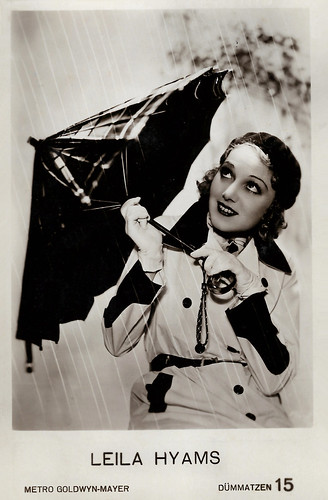
Cigarette card by Godfrey Phillips Ltd. and Associated Companies in the Beauties of To-day series, Second Series, no. 19.

Dutch postcard, no. 14. Photo: Metro-Goldwyn-Mayer.

German postcard by Ross Verlag, no. 4520/1, 1929-1930. Photo: Metro-Goldwyn-Mayer.

French postcard by Europe, no. 670. Photo: Metro-Goldwyn-Mayer.

Dutch postcard by JosPe, Arnhem, no. 368. Photo: Metro-Goldwyn.
Her blonde hair, delicate features and innocent sex appeal
Leila Hyams was born in 1905 in New York City, USA. Her parents were the vaudeville comedy performers John Hyams and Leila McIntyre. Both her parents had careers in films and can be seen together in The Housekeeper's Daughter (1939).
As soon as she could walk, Leila appeared onstage with her parents, and as a teenager, she worked as a model and became well-known after appearing in a successful series of newspaper advertisements. She was the first person to model for Listerine mouthwash.
This success led her to Hollywood, and she made her first film appearance in Sandra (Arthur H. Sawyer, 1924) with Barbara La Marr. Her blonde hair, delicate features and innocent sex appeal led to a variety of supporting roles, where she was required to do very little but smile and look pretty. She proved herself capable of handling these parts, and she came to be taken seriously as an actress.
By 1928 she was appearing in starring roles and achieved success in MGM's first talking film, Alias Jimmy Valentine (Jack Conway, 1928) opposite William Haines and Lionel Barrymore. It was followed by Spite Marriage (Edward Sedgwick, 1929) starring Buster Keaton.
She was once described as 'The Golden Girl' by an artist because of her perfect pink skin and blonde hair colouring and, according to a 1928 Photoplay Magazine article, she carried a small satin case suspended from her garter that contained an extra pair of stockings, in case the ones she was wearing were damaged. Leila appeared opposite Conrad Nagel in the popular murder mystery The Thirteenth Chair (Tod Browning, 1929), a role that offered her the chance to display her dramatic abilities as a murder suspect.

Belgian postcard by S.A. Cacao et Chocolat Kivou, Vilvo[o]rde, Belgium.

Spanish postcard in the Estrellas del cine series by Editorial Grafica, Barcelona, no. 117. Photo: Metro-Goldwyn-Mayer.

British postcard in the Second Cinema Stars series by Sarony Cigarettes, no. 70. Photo: Warner Bros.

Italian postcard by FotoFlou, no. 115.
A versatile, excellent actress
The quality of Leila Hyams's parts continued to improve, which included a role as Robert Montgomery's sister in the prison drama The Big House (George W. Hill, 1930), with Chester Morris and Wallace Beery, for which she again received positive reviews.
She is best remembered for two early 1930s horror movies. In Tod Browning's controversial Freaks (1932), she played the wise-cracking, kind-hearted circus performer Venus and gave a compassionate performance. Next, she was the heroine in Island of Lost Souls (Erle C. Kenton, 1932) with Charles Laughton and Bela Lugosi.
She also appeared in the sexy and funny Jean Harlow film Red-Headed Woman (Jack Conway, 1932), and the musical comedy The Big Broadcast (Frank Tuttle, 1932) with Bing Crosby in his first starring role, George Burns, and Gracie Allen. Another memorable performance was as the good-natured saloon girl who teaches Roland Young to play the drums in Ruggles of Red Gap (Leo McCarey, 1935). Her last film was Yellow Dust (Wallace Fox, 1936) with Richard Dix.
After ten years and 50 films, Leila decided to concentrate on her personal life and retired from acting in 1936. Alicia T at IMDb: "A versatile, excellent actress she was, able to conform to any role and maintain that special heartfelt sincerity she always displayed in her role. Her image on screen was beautiful but not conceited, not high and mighty, tough but sweet and she had sex appeal but always came across as a lady who managed to keep her innocence. Those were the qualities that carried her to fame and set her apart from the other leading ladies of early Hollywood."
After her retirement, Hyams remained a part of the Hollywood community. Reportedly, she was very shrewd about protecting her assets, putting a picture of herself on all her checks so they would be impossible to cash if they were stolen. Hyams returned once to the screen as a Red Cross worker in the short First Aid (Will Jason, 1943). She was married to agent Phil Berg for 50 years, from 1927 until her death. Leila Hyams passed away from natural causes in 1977, in Bel-Air, CA. She was 72.

Italian postcard by Cinema-Illustrazione, series II, no. 15. Photo: Metro-Goldwyn-Mayer. John Gilbert and Leila Hyams in Way of a Sailor (Sam Wood, 1930).

German postcard by Ross Verlag, no. 4755/1, 1929-1930. Photo: Metro-Goldwyn-Mayer.

German postcard by Ross Verlag, no. 5102/1, 1930-1931. Photo: Metro-Goldwyn-Mayer. Johnny Mack Brown and Leila Hyams starred together in such films as Hurricane (Ralph Ince, 1929) and Saturday's Millions (Edward Sedgwick, 1933).

German postcard by Dümmatzen, no. 15. Photo: Metro-Goldwyn-Mayer.

Spanish postcard by Dümmatzen, no. 118. Photo: Metro Goldwyn Mayer. Leila Hyams and Johnny Weissmuller.
Sources: Alicia T (IMDb), M.G. Nylander (IMDb), Wikipedia and IMDb.
No comments:
Post a Comment